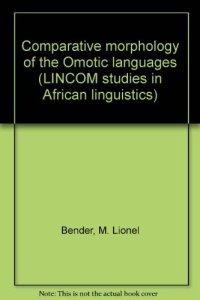
Ebook: Comparative morphology of the Omotic languages
Author: M. Lionel Bender
- Genre: Linguistics // Linguistics
- Tags: Arts Photography Biographies Memoirs Business Money Calendars Comics Graphic Novels Computers Technology Cookbooks Food Wine Crafts Hobbies Home Education Teaching Engineering Transportation Gay Lesbian Health Fitness Dieting History Humor Entertainment Law Literature Fiction Mystery Thriller Suspense Parenting Relationships Politics Social Sciences Reference Religion Spirituality Romance Science Math Fantasy Self Help Sports Outdoors Teen Young Adult Test Preparation Travel
- Series: LINCOM studies in African linguistics
- Year: 2000
- Publisher: LINCOM Europa
- Language: English
- pdf
Omotic is the least-known family in the Afrasian (=Afroasiatic or "Hamito-Semitic") phylum. No book-length synthesis of the family has appeared previously and it is not generally known that Omotic is a highly agglutinative family with many obvious Afrasian characteristics. Omotic is located entirely within southwest and west Ethiopia, on both sides of the Omo River, from which it takes its name. Some still consder Omotic not to be an independent family, but rather West Cushitic. In this monograph, the author covers all nine Omotic families in descriptive chapters as follows: 1. Northwest Ometo, 2. Southeast Ometo and C'ara, 4. Gimira-Yem (Janjero)-Kefoid, 6. Dizoid, 7. Aroid, 8. Mao. Chs. 3 and 5 are analytic chapters covering preceding chapters and Ch. 9 is an overall analysis, summary, and conclusions. All varieties having sufficient documentation (about 30 in number) are covered, along with notes on others. Sources are all available published sources which contain significant linguistic material, many of them obscure and difficult to obtain, plus extensive unpublished fieldnotes of the author and others. All are fully referenced. Each descriptive chapter has an introduction featuring nomenclature, locations, demographic estimates, and a listing of main sources. There follows a brief phonological sketch divided into consonants, vowels, and suprasegmentals and phonotactics. Morphological categories are then taken up in the order: pronouns, including independents, possessives, verbal affixes, gender, number, and case; demonstratives; interrogatives; nouns, including species and the categories applying to pronouns; verbal TMA (tense-mode-aspect) system; copulas and connecters; nominal and verbal derivations. In the comparative analysis, the author surveys grammatical formatives by family and indicates potential proto-forms where possible. Conclusions include remarks on the sub-classification of Omotic and the position of Omotic in the Afrasian phylum.
Download the book Comparative morphology of the Omotic languages for free or read online
Continue reading on any device:

Last viewed books
Related books
{related-news}
Comments (0)